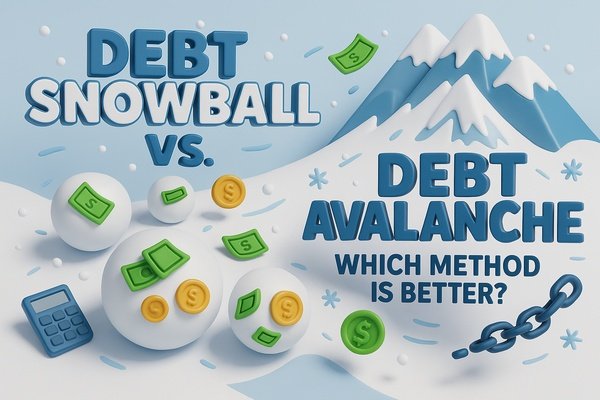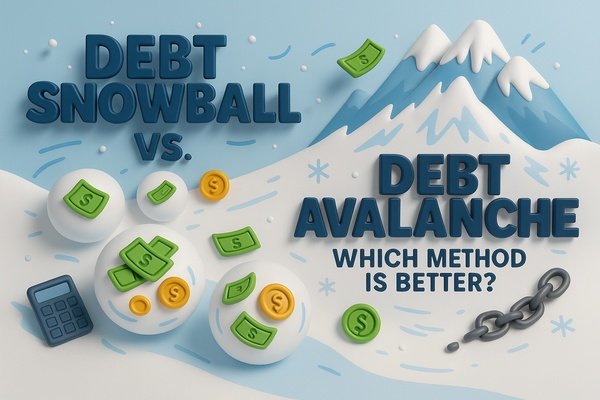Introduction to debt snowball vs. debt avalanche
Paying off debt can feel overwhelming, especially when you’re juggling multiple credit cards, loans, interest rates, and minimum payments. Without a clear plan, it’s easy to feel stuck or lose motivation altogether. That’s why choosing the right payoff strategy can make a massive difference in your journey to financial freedom.
Two of the most widely recommended methods are the debt snowball and debt avalanche strategies. While both are designed to help you eliminate debt, they go about it in very different ways. In the debt snowball vs. debt avalanche comparison, each method offers its own set of strengths, depending on your personality, financial habits, and motivation style.
The debt snowball method focuses on paying off your smallest balances first. It delivers quick emotional wins and can be incredibly motivating for those who need to see progress right away. On the flip side, the debt avalanche method prioritizes debts with the highest interest rates first; saving you more money in the long run and reducing the total cost of repayment.
So which method should you choose? The answer isn’t always obvious. It depends on whether you’re more motivated by emotional victories or long-term savings. In this article, we’ll dive into the five key differences between the debt snowball vs. debt avalanche approaches so you can make the best decision for your financial goals.
By the end, you’ll not only understand how both methods work, you’ll have the confidence to choose the one that fits your mindset, your budget, and your future. Let’s break down the real difference between the debt snowball vs. debt avalanche and help you take the next step toward a debt-free life.
1. Focus: Motivation vs. Math
The most fundamental difference in the debt snowball vs. debt avalanche debate lies in their core focus or what drives the strategy. Each method takes a distinctly different approach to prioritizing debt payments, and the choice between them depends largely on your mindset and financial personality.
Debt Snowball: Emotional Momentum
The debt snowball method focuses on paying off your smallest debts first, regardless of the interest rate. The idea is simple: by eliminating smaller balances quickly, you gain momentum and confidence. This emotional boost can be incredibly motivating, especially if you’ve been feeling overwhelmed or discouraged by your financial situation.
With the debt snowball, the act of crossing a debt off your list. Even if it’s not the one costing you the most in interest, can create a powerful psychological victory. This sense of achievement builds motivation to tackle the next balance and continue moving forward. In behavioral finance, this kind of positive reinforcement is a key driver for long-term success. That’s why, in the debt snowball vs. debt avalanche debate, many experts recommend snowball for people who struggle with consistency or need quick wins.
Debt Avalanche: Mathematical Efficiency
The debt avalanche method, on the other hand, is all about maximizing efficiency. It prioritizes debts by interest rate, not balance. You begin by paying extra toward the debt with the highest interest rate, while maintaining minimum payments on the rest. This approach helps reduce the total amount of interest you pay over time, making it the smarter option mathematically.
The avalanche strategy is ideal for people who are disciplined, numbers-driven, and focused on financial optimization. While it may take longer to see your first win, the savings can be significant, especially when interest rates are high. For individuals who are patient and results-oriented, the debt avalanche often wins the battle of logic in the debt snowball vs. debt avalanche comparison.
Which Focus Is Right for You?
If you’re comparing the debt snowball vs. debt avalanche, the real question becomes: what keeps you going; quick emotional victories or maximum financial savings?
Both methods are effective, but they cater to different mindsets. The debt snowball vs. debt avalanche decision ultimately depends on your personality, behavior, and what’s more likely to keep you consistent over time.
In the end, success isn’t just about numbers, it’s about momentum, motivation, and mindset. So choose the strategy that aligns with your habits and gets you to the finish line. Because in the debt snowball vs. debt avalanche debate, the best plan is the one you’ll actually stick with.
2. Speed of Results: Emotional Wins vs. Financial Efficiency
Both methods aim to help you become debt-free, but the pace and emotional experience of the journey can be very different. In the debt snowball vs. debt avalanche comparison, understanding how each method affects your speed of results is key to choosing the one that will work best for you.
Debt Snowball: Fast Early Wins
The debt snowball method gives you a quick psychological boost. By focusing on paying off the smallest balances first, you’re likely to eliminate one or more debts in the first few months. This creates an emotional “win” and builds momentum; like a snowball rolling downhill, gaining size and speed.
This approach is particularly powerful if you’re someone who thrives on seeing visible progress. Crossing debts off your list gives you a sense of accomplishment and fuels motivation to keep going. For many people, this emotional feedback is exactly what they need to maintain focus and discipline.
However, the trade-off is that the debt snowball ignores interest rates. That means you may end up paying more interest over time and potentially extending your overall payoff period, especially if larger, high-interest debts are left for last.
Debt Avalanche: Slower Start, Faster Finish
The debt avalanche method works in the opposite way. It tackles the debt with the highest interest rate first, regardless of balance. This approach saves you more money in the long run by reducing the total amount of interest you pay.
But because high-interest debts are often larger balances, your first “win” might take months to achieve. That delay in visible progress can be discouraging, especially if you’re emotionally driven. It requires patience, consistency, and trust in the math.
Still, if you stick with it, the debt avalanche can get you out of debt faster and cheaper. Over time, the money saved on interest can be significant.
Snowball vs. Avalanche: What’s More Important to You?
So, which method is better in terms of speed? It depends on what “speed” means to you.
In the debt snowball vs. debt avalanche debate, it’s a question of emotional wins vs. financial efficiency. The best method is the one that keeps you engaged long enough to reach the finish line. Consistency, not perfection, is what ultimately leads to success.
3. Interest Paid Over Time
This is the area where the debt avalanche method clearly outperforms its counterpart. If your goal is to minimize the total cost of your debt, then the debt avalanche vs. debt snowball conversation leans heavily in favor of the avalanche.
The logic is simple: by tackling the highest interest rate first, you reduce the amount of interest accruing over time. That means more of your money goes toward paying down the principal balance instead of being eaten up by interest charges.
Let’s look at an example:
Suppose you have two debts:
The debt avalanche approach would have you focus on the credit card first, because it’s costing you more in interest even if it takes longer to pay off. By knocking out the high-interest debt early, you limit how much you’re paying in the long run.
The debt snowball, on the other hand, would target the $1,000 personal loan first. Simply because it’s the smallest balance. This gives you a quick emotional win, but allows the larger, high-interest debt to continue accruing costly interest.
When comparing debt snowball vs. debt avalanche, the financial difference becomes even more noticeable as your debt grows or interest rates vary widely. In some cases, the avalanche method can save you hundreds or even thousands of dollars in interest.
However, it’s important to recognize that interest savings alone don’t guarantee success. Many people abandon their debt payoff plan not because it’s inefficient, but because it doesn’t feel rewarding. That’s why the debt snowball is still a valid approach: if emotional momentum keeps you consistent, it may be worth the extra interest in the long term.
So, how should you decide between the debt snowball vs. debt avalanche?
At the end of the day, both strategies work, but this is the point where you need to balance math vs. mindset and decide what matters more to you: saving money or gaining momentum.
4. Flexibility and Discipline
When it comes to staying consistent and adaptable over time, both the debt snowball and debt avalanche methods have their strengths, but they cater to different personalities and financial mindsets. Understanding how your habits and lifestyle align with each method is essential when choosing between the debt snowball vs. debt avalanche strategies.
Debt Snowball: Flexible and Encouraging
The debt snowball method is widely regarded as the more flexible option, particularly for beginners or those who have struggled with debt in the past. Its structure is straightforward: start with your smallest debt first, regardless of interest rate. Paying off a balance quickly provides an immediate sense of progress, which boosts confidence and encourages momentum.
This method is especially effective if:
If your financial situation changes, such as job loss, medical bills, or an emergency expense, you can easily pause or adjust your payments without derailing your progress. This kind of flexibility makes the debt snowball a reliable option in the debt snowball vs. debt avalanche conversation for people who crave encouragement and emotional reinforcement.
Debt Avalanche: Disciplined and Structured
The debt avalanche method requires more discipline and patience. It focuses on paying off the highest interest debt first, regardless of balance. While it doesn’t deliver immediate emotional satisfaction, it does save you more money in the long run by minimizing total interest paid.
This approach is ideal for people who:
In the early phases, the debt avalanche can feel slower since you may not eliminate a balance right away. But for those who can delay gratification, this strategy is often the better long-term choice. It’s the financially optimal route in the debt snowball vs. debt avalanche debate, especially when interest rates vary significantly across debts.
Still unsure which strategy suits you best? The Consumer Financial Protection Bureau offers valuable insights to help you compare both debt repayment strategies based on personality, income, and financial goals.
Ultimately, the best method in the debt snowball vs. debt avalanche debate isn’t about right or wrong, it’s about choosing the plan that keeps you consistent, confident, and committed to becoming debt-free.
Final Thought on Flexibility vs. Discipline
Deciding between the debt snowball vs. debt avalanche method is more than just a numbers game, it’s about understanding yourself, your motivations, and what will keep you on track when the road gets tough. Both strategies are proven, both are effective, and both can help you eliminate debt for good. The real difference lies in how you want to experience that journey.
The debt snowball method is a fantastic option for people who are motivated by fast progress and small wins. If seeing immediate results is what keeps you moving forward, then this method gives you the boost you need. By knocking out your smallest debts first, you gain emotional momentum and confidence; two things that are often more important than just saving money. In the debt snowball vs. debt avalanche discussion, snowball wins when it comes to simplicity and motivation.
On the other hand, the debt avalanche method is ideal for people who are driven by logic and want to pay off debt in the most financially efficient way. If you’re comfortable waiting a bit longer for that first win and prefer long-term savings over short-term emotional gratification, the avalanche method may be your perfect match. It’s especially useful when you’re dealing with large debts that carry high interest rates.
But here’s the truth: personal finance is personal. There is no “one-size-fits-all” solution. That’s why the debt snowball vs. debt avalanche conversation isn’t about finding the perfect method; it’s about finding the perfect method for you.
Some people even blend both methods. Starting with a snowball to build momentum, then switching to avalanche to save on interest. That’s the beauty of taking control: you get to choose what works best and adjust as needed. The important part is that you have a plan, you’re making progress, and you’re not letting debt control your life.
So which should you choose?
Either way, you’re doing the most important thing: taking action. That step alone sets you apart from the majority who continue to let debt pile up without a strategy.
Whichever side of the debt snowball vs. debt avalanche debate you land on, remember that consistency beats perfection. Stay committed. Track your progress. Celebrate your milestones, and keep moving forward; one payment at a time until you reach your goal of financial freedom.
You’ve got this.






